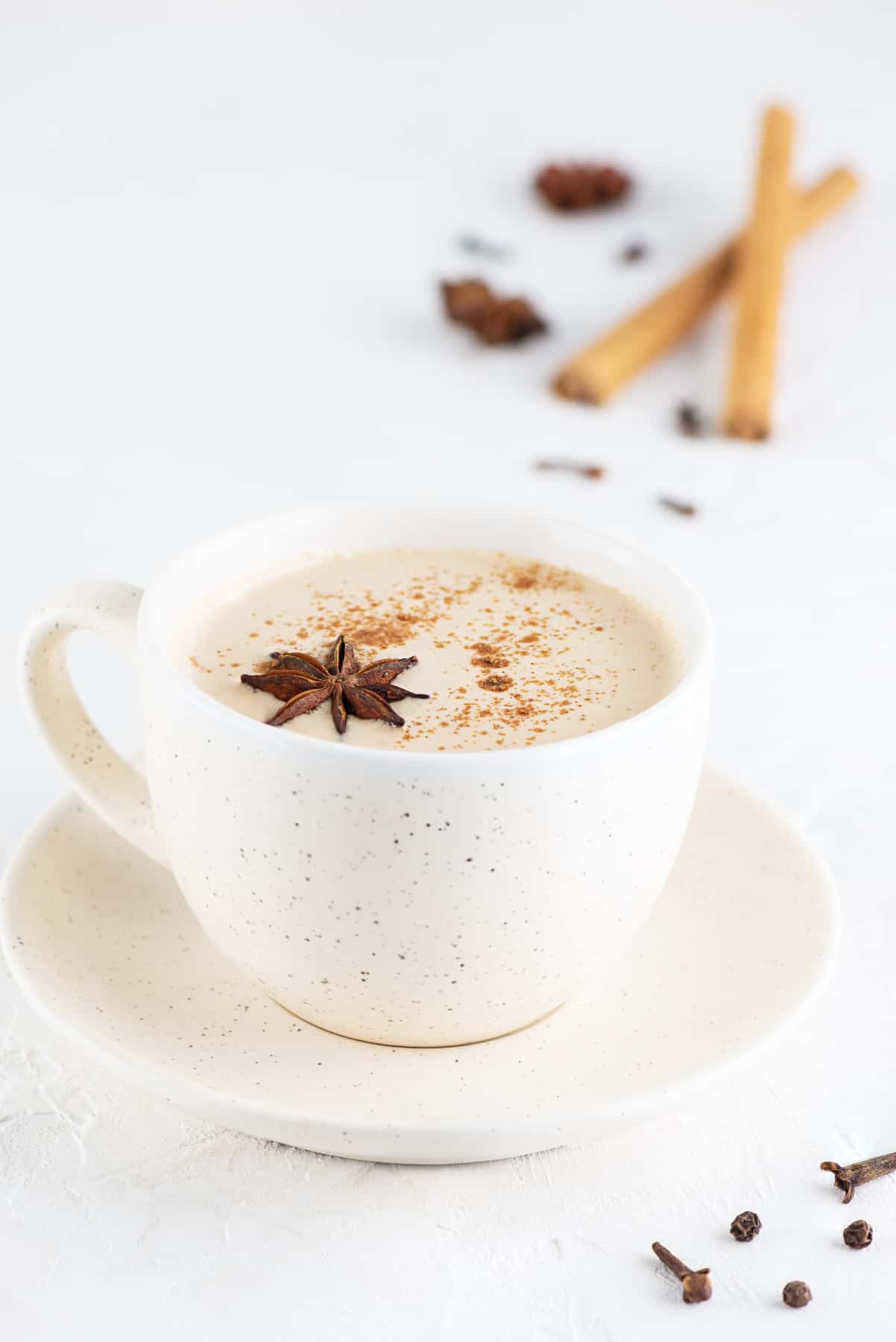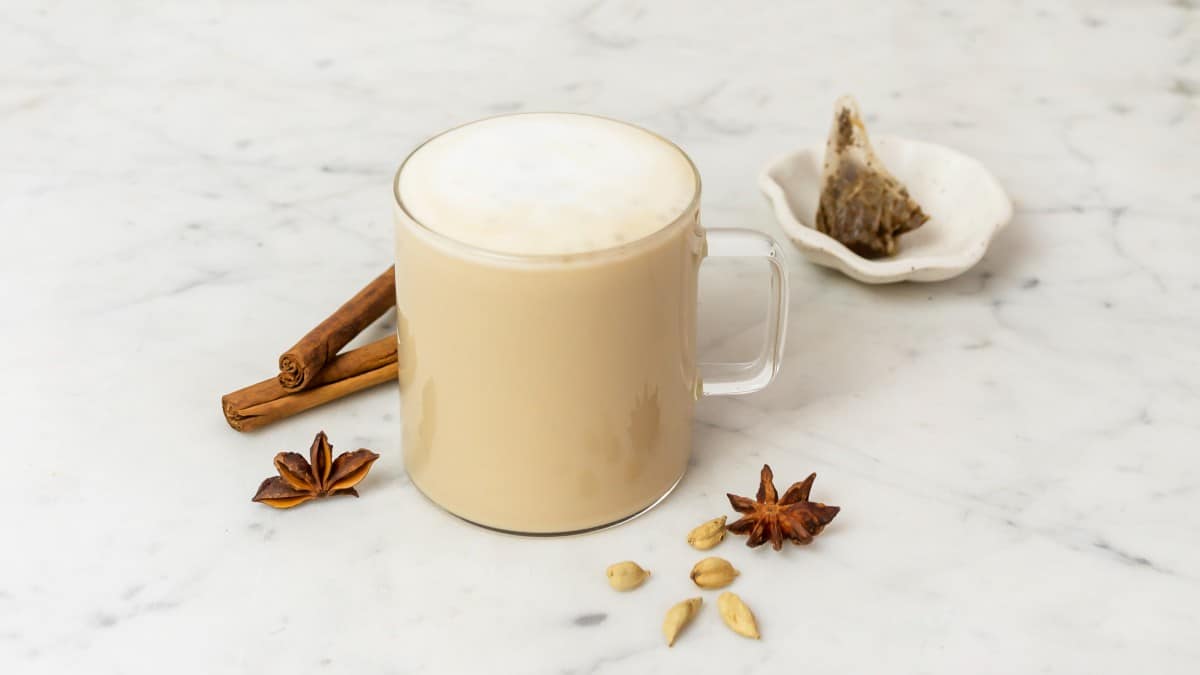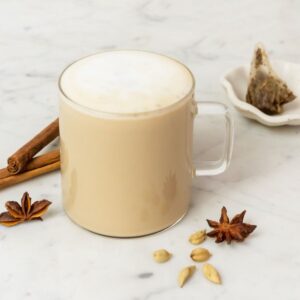Is Chai Latte Healthy? (Healthier Chai Latte Recipe)
This post may contain affiliate links. As an Amazon Associate I earn from qualifying purchases.
A chai latte is the perfect mix of sweetness and spice, but you may wondering: is a chai tea latte healthy? It’s a great question. Is this aromatic brew a secret superfood, a sneaky sugar fiend, or something in between? Well, my friend, you’re in the right place. We’re about to take a no-nonsense, deep dive into chai lattes – exploring the good, the not-so-good, and everything in between.

As an Amazon Associate I earn from qualifying purchases. You can read my full disclosure HERE.
A chai latte is basically a fusion of Eastern and Western culinary tradition, it’s got the bold spices and strong black tea from the East, and then it’s all mixed up in a milky, frothy way that’s pretty popular in the West. It’s kind of like the best of both worlds in a single cup.
Check out my guide on: Healthy Ways To Sweeten Coffee
Here’s the simple rundown of what goes into a classic chai latte:
- Black Tea: The backbone of the chai latte is good old black tea. You need a strong one, like Assam or Darjeeling, that can hold its own when we start adding in all the other good stuff.
- Spices: This is where the magic happens. Traditional chai spices are cardamom, cinnamon, ginger, cloves, and black peppercorns, but you can mix it up with star anise, nutmeg, or fennel seeds if you fancy.
- Milk: This isn’t just a tea, it’s a latte, which means plenty of milk. You can use any type of milk you like – dairy milk, soy milk, almond milk, oat milk, you name it. The key is to steam it up nice and frothy.
- Sweet Stuff: Now, here’s where we gotta be a little careful – especially if your goal is weight loss. Chai lattes are usually sweet, which is partly why they taste so good. They can be sweetened with regular sugar, honey, or a sugar substitute. Keep in mind: Too much sugar can sneak up on you in drinks like these.
- Froth: Just like a coffee latte, we top off a chai latte with a little frothed milk. It’s like the cherry on top, but in this case, it’s a creamy, velvety cloud of milk.
Nutritional Breakdown of a Chai Latte
Alright, let’s break down what’s in a typical chai latte from a nutritional standpoint. Keep in mind that exact amounts can vary based on how the latte is made:
Calories: A 16-ounce chai latte from a café can clock in around 200-250 calories. This mostly comes from the milk and any added sweeteners. Making your chai latte at home where you control the ingredients can reduce the calories.
Sugar: This is the tricky part. A store-bought chai latte can contain up to 40 grams of sugar, thanks to syrups and sweeteners. If you’re sweetening it yourself, you can keep this way lower.
Protein: Thanks to the milk, a chai latte can be a decent source of protein. You could get around 8-10 grams in a 16-ounce serving.
Fat: Depending on the type of milk used, the fat content can vary. A typical chai latte made with 2% milk might have about 5 grams of fat.
Carbohydrates: Between the milk and the sugar, a chai latte can have around 45 grams of carbs, but this can be significantly reduced if you choose low-sugar and low-fat milk options.
Caffeine: Don’t forget the caffeine! A chai latte does contain caffeine from the black tea, usually ranging between 40-60mg for a 16-ounce cup.
Vitamins and Minerals: Chai lattes also offer some nutritional perks like calcium, vitamin D, and B vitamins, thanks to the milk.
Potential Health Benefits of Chai Latte
Let’s break down some potential health benefits:
Antioxidant Powerhouse: Both black tea and the spices used in chai have antioxidant properties. These help to reduce inflammation in the body, boost your immune system, and can even protect your cells from damage and free radicals.
Heart Health: There is some research to suggest that the flavonoids found in black tea can improve heart health, lower, blood pressure, and reduce cholesterol.
Boosts Energy and Focus: Thanks to the moderate caffeine content from the black tea, a chai latte can give you a gentle energy boost without the jitters that some people experience from coffee.
Are All Chai Lattes Created Equal?
Let’s get real for a moment. Not all chai lattes are created equal. Not by a long shot. From the local coffee shop on the corner to the jug of concentrate in your fridge, there are as many versions of chai latte as there are stars in the sky (okay, maybe not that many, but you get the point).
Store-bought versus Homemade: A chai latte that you whip up in your own kitchen can be a world apart from the one you grab at a café. Cafes often use sweetened chai concentrates, which can send the sugar content through the roof. When you make it at home, you control what goes in your cup, which means you can limit the sweet stuff and keep it all natural.
Recipe Variations: Chai latte recipes can be as unique as the person making them. Some might have a base of strong black tea and a blend of spices. Others might use a premixed chai tea bag or concentrate. The type of milk, the proportion of tea to milk, and the amount and type of sweetener can all vary. All these factors can change not only the taste but also the nutritional profile of your chai latte.
Different Milks: Whole milk, skim milk, oat milk, coconut milk – the type of milk you choose can significantly impact the nutritional value of your chai latte. For example, using whole milk will increase the fat content, while using a sweetened almond milk could add to the sugar content.
In short, there’s a big range when it comes to chai lattes. While they all share some common elements – tea, spices, milk, sweetness – the final product can be quite different depending on how it’s made.
Making Your Chai Latte Healthier
Let’s chat about how you can still enjoy a chai latte – but with a healthier twist:
- The Sweet Stuff: Sugar or sweetened concentrates can jack up the calorie count in your chai latte. Now, if you’re like me and love a hint of sweetness to complement those warm spices, consider using natural sweeteners like stevia or monk fruit. They’re much lower in calories and won’t spike your blood sugar levels like regular sugar. Even using honey or maple syrup in moderate amounts can be healthier than processed sugar.
- Milk Matters: Whole milk might give your chai latte that creamy dreaminess, but it is also higher in fat. To lighten things up, switch to low-fat milk or even a non-dairy milk. Almond, oat, and soy milk are all good options and each adds its own unique flavor. If you’re going for a plant-based milk, choose the unsweetened versions to avoid extra sugar.
- Make It At Home: Making your chai latte at home can be healthier because you’re in control. Use fresh spices like cinnamon, cardamom, ginger, and black pepper to brew your tea. Not only will the aroma transport you straight to a spice market in the East, but these spices also have health benefits. Plus, by brewing at home, you can control the sugar and fat content, making it easier to fit a chai latte into a balanced diet.
- Portion Control: This might seem obvious, but simply reducing the size of your chai latte can make it healthier. If you usually go for a 16-ounce serving, try reducing it to 12 ounces. You still get to enjoy the flavors, but with fewer calories and less sugar.
- Get Active: Now, you’re probably thinking, “What does activity have to do with a chai latte?” Well, as a nutrition coach, I know that staying active is a part of the overall health picture. So, why not turn your chai latte time into an opportunity for a little exercise? Instead of meeting a friend at a café, grab your chai lattes to go and enjoy a walk while you chat. This is such a great way to get your steps in!
Balancing the foods and drinks you enjoy with healthier choices doesn’t mean sacrificing flavor or enjoyment. With a few tweaks and adjustments, you can make your chai latte a drink that not only tastes good but also fits better into a healthy lifestyle. Cheers to that! ☕️

The Starbucks Chai Tea Latte Breakdown
Starbucks, being one of the largest coffee chains in the world, has made its own version of the chai tea latte pretty well-known. But like all chai lattes, the Starbucks version has its own unique recipe and nutritional profile:
What’s In It?
The Starbucks chai latte is made with a chai concentrate and milk. The chai concentrate contains black tea, sugar, honey, cardamom, black pepper, ginger, cinnamon, cloves, and other flavorings.
Nutritional Content
A Grande Starbucks Chai Tea Latte (16 fl oz) made with 2% milk has 240 calories. It contains 5 grams of fat, 45 grams of carbs, and 8 grams of protein. However, one key thing to note is that it contains 42 grams of sugar – that’s about 10 teaspoons!
Health Considerations
While the Starbucks chai latte does offer some protein and small amounts of vitamins and minerals, the high sugar content is a downside from a health perspective. Consuming high-sugar beverages regularly can lead to weight gain and other health issues.
Making It Healthier
You can customize your Starbucks chai latte to make it a bit healthier. Consider asking for fewer pumps of chai concentrate. A grande order comes with 4 pumps of concentrate so you could try 2 instead. You could ask for a “light” or “less sweet” version, or choose a non-dairy milk option if you prefer.
Alternatively, you could order a chai tea (made from chai tea bags – not a latte) and add stevia, ask for steamed almond milk, and top with extra cinnamon.
Remember, the Starbucks Chai Tea Latte, like any other beverage, can be enjoyed in moderation as part of a balanced diet. If it’s a daily must-have for you, consider some of these modifications to make it a bit healthier.
How To Make A Homemade Healthy Chai Latte
Does brewing a chai latte at home feels like a mission? Gathering all those spices, brewing the tea, getting the milk-to-tea ratio just right – it can feel a bit like a science experiment. But what if I told you there’s an easier way? One that brings the cafe right into your kitchen without any fuss?
Enter TAZO Skinny Chai Latte Iced Tea Concentrate. I am OBSESSED with this stuff. It delivers all the spicy, full-bodied flavor of a traditional chai latte, but with fewer calories and less sugar. The best part? No need to play around with a bunch of different spices or wait for your tea to brew. TAZO has done all the hard work for you, all you need to do is mix the concentrate with your choice of milk, and voila, you have a delicious, healthier chai latte that is also much easier on your waistline AND your wallet.
Bonus: It’s super easy to find…you can order it on Amazon (check out the rave reviews) but they also carry it at Walmart as well as most grocery stores. Getting it from Walmart will be much cheaper then getting it on Amazon.
Healthy Chai Tea Latte Recipe Ingredients
You’ll need the following ingredients to make a Homemade Healthy Chai Latte:
- 1/2 cup of TAZO Skinny Chai Latte Iced Tea Concentrate
- 1/2 cup of milk (or a dairy-free alternative if preferred)
- Cinnamon for garnish
How To Make A Healthy Chai Tea Latte : Step by Step
- Pour the TAZO Chai Tea Concentrate into a glass or mug.
- In a separate container, heat the milk until hot but not boiling. You can do this either on the stovetop or in a microwave.
- Froth the milk until it’s foamy. You can do this with a milk frother, a handheld frother, or even in a blender. Be sure to froth the milk after heating it, as this will give it a better foam.
- Pour the frothed milk into the mug with the chai concentrate.
- Top with a sprinkle of cinnamon and enjoy!
Recipe Tips and Tricks
If you prefer your chai tea very hot, mix the TAZO Chai Tea Base into your milk first, then heat ’em up together until it’s as hot as you like it. Then froth.
Some non-dairy milk alternatives may not froth well, resulting in a less full cup due to the absence of foam. In this case you can use 3/4 cup of the chai base and 1 cup of milk.
Additions, Substitutions, and Variations
SUBSTITUTIONS
Milk: The type of milk you choose can significantly change the taste and nutritional content of your chai latte. Want a creamier latte? Try full-fat oat milk. Looking to increase your protein intake? I love using Fairlife Ultra Filtered Milk. Want a nuttier flavor? Go for almond milk. Remember, you can always choose unsweetened versions to keep sugar levels down.
Sweetening Alternatives: TAZO Skinny Chai Latte Iced Tea Concentrate is already lightly sweetened, but if you crave a touch more sweetness, consider adding a drizzle of honey, a spoonful of stevia, or a dash of monk fruit sweetener.
ADDITIONS
Spice it Up: If you want a spicy chai latte, consider adding a pinch of extra ground cinnamon, nutmeg, or even a tiny bit of cayenne for a warming kick.
VARIATIONS
Cold vs. Hot: This concentrate can be used for both hot and iced chai lattes. So, you can sip a cool, refreshing iced chai on hot days or enjoy a warm, soothing hot chai when you need a cozy pick-me-up.
The Dirty Chai Latte: Want a caffeine kick with your chai? Add a shot of espresso to your TAZO Skinny Chai Latte to create a “Dirty Chai”. It’s the perfect spicy, wake-up call for those groggy mornings.
Frequently Asked Questions
My Favorite
Healthy Breakfast Recipes

Is Chai Latte Healthy? (Healthier Chai Latte Recipe)
Ingredients
- 1/2 cup TAZO Skinny Chai Latte Iced Tea Concentrate
- 1/2 cup milk (or a dairy-free alternative if preferred)
- cinnamon for garnish
Instructions
- Pour the TAZO Skinny Chai Latte Iced Tea Concentrate into a glass or mug.
- In a separate container, heat the milk until hot but not boiling. You can do this either on the stovetop or in a microwave.
- Froth the milk until it’s foamy. You can do this with a milk frother, a handheld frother, or even in a blender. Be sure to froth the milk after heating it, as this will give it a better foam.
- Pour the frothed milk into the mug with the chai concentrate.
- Top with a sprinkle of cinnamon and enjoy!
Notes
- If you prefer your chai tea very hot, mix the TAZO Chai Tea Base into your milk first, then heat them up together until it’s as hot as you like it. Then froth.
- Some non-dairy milk alternatives may not froth well, resulting in a less full cup due to the absence of foam. In this case you can use 3/4 cup of the chai base and 1 cup of milk.
Nutrition
The nutritional details for recipes are estimated using MyFitnessPal and can vary with different products, measurement accuracy, and source reliability. We aim to provide accurate information but cannot guarantee the precise accuracy of the nutritional data
